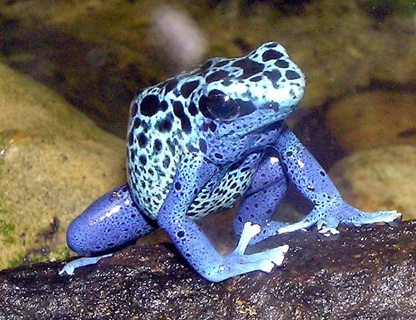We're open daily! View holiday hours
Science News
Poison Frog Athletes
March 30, 2011

In the middle of the Barry Bonds trial, the World Cup of Cricket and March Madness comes some very timely science news about frogs. Turns out that poison makes them better athletes. Who knew?
Two researchers publishing in this week’s Proceedings of the National Academy of Sciences knew. They subjected nearly 500 poison frogs from forests in Colombia, Ecuador, Venezuela, and Panamá to a frog fitness test. They measured their oxygen uptake during exercise using a rotating plastic tube, turning the tube like a hamster wheel to make the frogs walk.
Estimating the frogs' metabolic rates while at rest, and again after four minutes of exercise, they discovered that the most dazzling and deadly species had higher aerobic capacity than their drab, nontoxic cousins.
“They're better able to extract oxygen from each breath and transport it to their muscles, just like well-trained athletes,” said lead author Juan Santos of the National Evolutionary Synthesis Center in Durham, NC.
This athleticism has to do with their picky eating habits. Unlike snakes and other poisonous animals that make their own venom, poison frogs get their toxins from their food.
“They acquire their alkaloid chemicals by eating ants and mites,” explained co-author David Cannatella of the University of Texas at Austin. Because of this specific diet, poisonous frogs have to forage far and wide for food. “Nontoxic species basically stay in one place and don't move very much and eat any insect that comes close to them,”Santos said. “But the bright, poisonous frogs are very picky about what they eat.”
This combination of toxic skin and bold colors—a syndrome known as aposematism—evolved in tandem with specialized diet and physical fitness multiple times across the poison frog family tree, the authors explained. In some cases the frogs' physical fitness may have evolved before their unusual diet, making it possible to forage for harder-to-find food. But the specific sequence of events was likely different for different branches of the tree, Santos said.